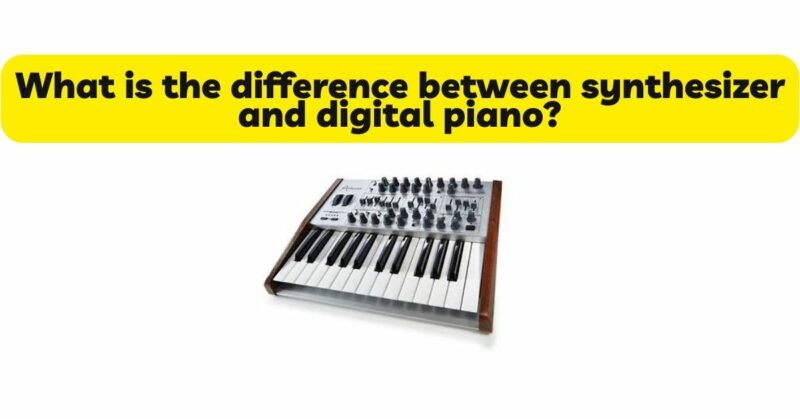Synthesizers and digital pianos are two popular keyboard instruments that offer distinct musical experiences. While both instruments share a keyboard layout, they differ in terms of sound generation, playing experience, and musical applications. In this article, we will explore the differences between synthesizers and digital pianos, shedding light on their unique characteristics. From sound production and key action to playing techniques and musical genres, we will delve into the nuances of each instrument, helping you make an informed decision when choosing between a synthesizer and a digital piano.
I. Sound Generation and Tonal Characteristics:
One of the key distinctions between synthesizers and digital pianos lies in their sound generation methods and tonal characteristics.
- Synthesizers: Synthesizers are designed for sound synthesis and manipulation. They generate sound electronically using oscillators, filters, and amplifiers. Synthesizers offer a wide range of tonal possibilities, from emulating traditional instruments to creating unique and experimental sounds. Musicians can sculpt and modify the sound using various parameters, envelopes, and effects. Synthesizers excel in providing flexibility and versatility in sound creation, allowing for sonic exploration and innovative timbres.
- Digital Pianos: Digital pianos are specifically designed to replicate the sound and playing experience of acoustic pianos. They utilize advanced sampling technology to capture the sound of real acoustic pianos, recording every note individually across the keyboard. Digital pianos strive to recreate the nuances and tonal characteristics of acoustic pianos, providing a realistic piano playing experience. They focus on delivering high-quality piano sounds and often include additional features such as different piano samples, pedal responses, and tonal variations.
II. Key Action and Playing Experience:
The key action and playing experience are important considerations when comparing synthesizers and digital pianos.
- Synthesizers: Synthesizers typically feature non-weighted or semi-weighted keys. These keys are lighter and more responsive compared to the weighted keys of acoustic pianos or digital pianos. The key action of a synthesizer is designed for playability and real-time sound manipulation. While they may lack the touch sensitivity and resistance of pianos, synthesizers offer features like aftertouch and pitch bend that enable expressive control and unique performance techniques.
- Digital Pianos: Digital pianos strive to replicate the touch and feel of acoustic pianos. They often feature weighted or graded hammer action keys, simulating the weight and response of an acoustic piano. The key action on a digital piano provides a more authentic piano playing experience, allowing pianists to develop proper finger technique, dynamics, and expression. The weighted keys provide a similar resistance to that of acoustic pianos, enhancing the realism and responsiveness of the instrument.
III. Playing Techniques and Musical Applications:
Playing techniques and musical applications differ between synthesizers and digital pianos.
- Synthesizers: Synthesizers invite a more exploratory and experimental approach to playing. They are commonly used in electronic music genres such as EDM, techno, and ambient. Synthesizer players often engage in sound design, real-time manipulation, and improvisation. Playing techniques on synthesizers involve manipulating parameters, creating complex textures, and utilizing effects to shape and evolve sounds. Synthesizers offer flexibility and creativity, allowing musicians to create unique sonic landscapes and push the boundaries of traditional playing techniques.
- Digital Pianos: Digital pianos are designed to cater to pianists and those seeking a traditional piano playing experience. They are well-suited for classical, jazz, and traditional music genres. Digital pianos support techniques such as legato, staccato, pedal control, and nuanced dynamics. Pianists can perform traditional piano repertoire, accompany other musicians, or use the instrument for practice and musical education. Digital pianos prioritize authentic piano sounds and playing techniques, enabling musicians to focus on the expressive qualities and tonal nuances of acoustic pianos.
IV. Features and Functionality:
Features and functionality differ between synthesizers and digital pianos, catering to different musical needs and preferences.
- Synthesizers: Synthesizers offer a wide range of features focused on sound manipulation and real-time control. They often include various modulation options, effects processors, and comprehensive parameter editing capabilities. Synthesizers can also offer sequencers, arpeggiators, and extensive patch storage for creating complex musical arrangements. These features allow musicians to shape and evolve sounds in a live performance or studio setting, making synthesizers a powerful tool for sound design and electronic music production.
- Digital Pianos: Digital pianos prioritize authentic piano sounds and playing experience. They typically include multiple piano sample variations, high-quality amplification systems, and realistic pedal responses. Digital pianos may also offer additional features such as built-in metronomes, recording capabilities, and connectivity options for MIDI or USB. While digital pianos may have limited sound editing capabilities compared to synthesizers, their focus on delivering a realistic piano experience is well-suited for those seeking a dedicated piano instrument.
Conclusion:
Synthesizers and digital pianos offer distinct musical experiences and cater to different musical preferences and applications. Synthesizers excel in sound synthesis, sonic manipulation, and versatility, allowing musicians to explore a wide range of genres and create innovative sounds. Digital pianos prioritize authenticity, aiming to replicate the sound and playing experience of acoustic pianos, making them ideal for pianists and those seeking a traditional piano playing experience.
When choosing between a synthesizer and a digital piano, consider your musical goals, preferred sound palette, playing techniques, and genre preferences. If you are interested in exploring electronic music genres, sound design, and sonic experimentation, a synthesizer may be the instrument of choice. On the other hand, if you are a pianist or seeking a realistic piano playing experience, a digital piano will provide the authentic touch and sound you desire.
Ultimately, the decision between a synthesizer and a digital piano depends on your individual musical aspirations, creative vision, and the instrument that resonates with your artistic expression. Embrace the instrument that inspires you and supports your musical journey, as both synthesizers and digital pianos offer unique opportunities for creativity and self-expression.


